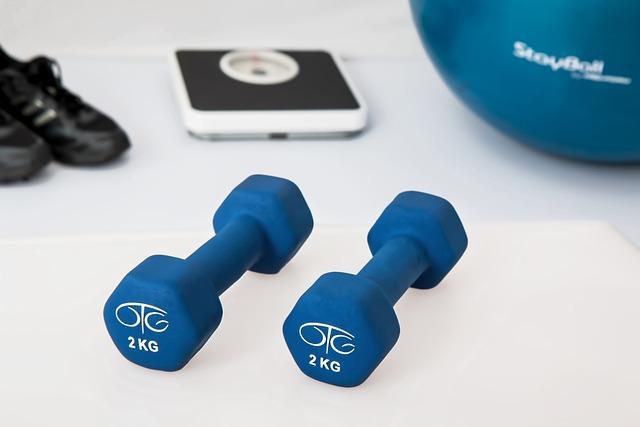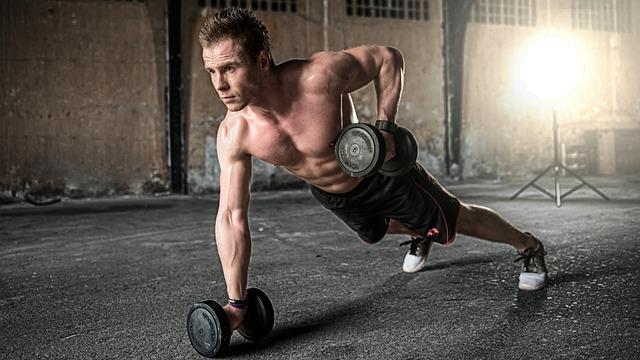Trap Dumbbell Workout: Target and Build Trap Muscles!

Are you ready to take your trap muscles to the next level? Look no further than the trap dumbbell workout! Whether you’re aiming to increase strength, improve posture, or simply enhance your overall look, this targeted and effective routine will help you achieve your goals. Get ready to learn the most efficient exercises, tips, and tricks to sculpt those traps like never before. Don’t let your progress be limited by traditional workout routines – it’s time to unlock the full potential of your trap muscles with this ultimate training guide. Let’s dive in and explore the world of trap dumbbell workouts together!
Contents
- 1. Anatomy of the Trapezius Muscles: Understanding the Key Players in Trap Development
- 2. The Benefits of Trap Dumbbell Exercises: Maximize Your Upper Body Strength and Functionality
- 3. Essential Trap Dumbbell Exercises: A Well-Rounded Workout Routine for Targeting Every Angle
- 4. Mastering Proper Form: Techniques and Cues for Maximum Trap Muscle Activation
- 5. Progression and Overload: Effective Strategies to Continuously Challenge and Develop Trap Muscles
- 6. Incorporating Variations: Shake Up Your Trap Dumbbell Workout for Better Results
- 7. Common Mistakes to Avoid: Pitfalls That Can Sabotage Your Trap Muscle Growth
- 8. Supplementing Your Workout: Nutrition and Recovery Tips for Optimal Trap Muscle Development
- 9. Balancing Trap Development: Targeting the Middle, Upper, and Lower Fibers of the Muscles
1. Anatomy of the Trapezius Muscles: Understanding the Key Players in Trap Development
The trapezius muscles, commonly referred to as "traps," are a vital part of your upper body and play a significant role in your overall posture and shoulder strength. Understanding the anatomy of the trapezius muscles is essential if you want to target and build these key players successfully. Let’s delve deeper into the structure of the traps and discover how certain exercises can help you develop them to their fullest potential.
The trapezius muscles are a large pair of triangular muscles that span from the base of your skull all the way down to your mid-back. They are divided into three distinct parts: the upper traps, middle traps, and lower traps. Each section has a unique function and can be specifically targeted to achieve optimal muscle development.
-
Upper Traps: The upper traps are responsible for lifting and shrugging your shoulders. To activate and strengthen this part of the trapezius muscles, exercises like dumbbell shrugs and upright rows can be highly effective. These movements isolate the upper traps and allow you to focus on the targeted muscle group.
-
Middle Traps: The middle traps are involved in retracting your shoulder blades, which is important for maintaining good posture. Exercises such as bent-over rows and scapular retractions can help develop this area. Incorporating these exercises into your workout routine will not only build your middle traps but also improve your overall posture.
- Lower Traps: The lower traps play a crucial role in shoulder stability and rotation. They are engaged when you pull your shoulder blades downward and together. Exercises like face pulls and prone Y raises specifically target the lower traps and can greatly enhance their strength and functionality.
By understanding the anatomy of the trapezius muscles and incorporating exercises that target each section, you can have a well-developed set of traps. Remember, consistency is key, so make sure to add these exercises into your regular workout routine for optimal trap development. Don’t shy away from challenging yourself, as the trapezius muscles can handle a significant amount of resistance to grow and become stronger.
2. The Benefits of Trap Dumbbell Exercises: Maximize Your Upper Body Strength and Functionality
There’s no denying the importance of having a strong upper body for overall strength and functionality. One area that often gets overlooked, but shouldn’t, is the trapezius or trap muscles. These muscles are located in the upper back and play a crucial role in shoulder movement and posture. Incorporating trap dumbbell exercises into your workout routine can help you target and build these muscles, giving you a more defined and strong upper body.
Here are some of the benefits of including trap dumbbell exercises in your workouts:
-
Increased strength: Trap dumbbell exercises, such as shrugs and upright rows, specifically target the trap muscles, helping to increase their strength and size. This can improve your overall upper body strength and allow you to lift heavier weights in other exercises.
-
Improved posture: Strong trap muscles are essential for maintaining proper posture. As these muscles become stronger, they can support the weight of your head and upper body, reducing the risk of slouching and rounded shoulders.
- Enhanced shoulder mobility: The trap muscles are involved in various shoulder movements, such as raising your arms overhead. By targeting and building these muscles, you can improve your shoulder mobility and flexibility, making everyday tasks and exercises easier and safer.
To maximize the benefits of trap dumbbell exercises, consider incorporating them into your upper body workout routine two to three times per week. Start with lighter weights and gradually increase the resistance as your strength improves. Remember to maintain proper form and engage your trap muscles throughout each exercise.
Here’s a sample trap dumbbell exercise routine:
Exercise 1: Dumbbell shrugs
- Stand with your feet shoulder-width apart and hold a dumbbell in each hand.
- Relax your shoulders and allow them to drop.
- Lift your shoulders toward your ears, squeezing your trap muscles at the top of the movement.
- Lower your shoulders back down to the starting position and repeat for 10-12 reps.
Exercise 2: Upright rows
- Hold a dumbbell in each hand, palms facing your body.
- Start with your arms extended in front of you, slightly wider than shoulder-width apart.
- Lift the dumbbells straight up toward your chin, keeping them close to your body.
- Squeeze your trap muscles at the top of the movement and then slowly lower the weights back down.
- Repeat for 10-12 reps.
Incorporating trap dumbbell exercises into your workout routine can help you maximize your upper body strength and functionality. These exercises can improve your shoulder mobility, enhance your posture, and increase overall strength. So don’t neglect your trap muscles—give them the attention they deserve and start reaping the benefits today!
3. Essential Trap Dumbbell Exercises: A Well-Rounded Workout Routine for Targeting Every Angle
The traps, short for trapezius muscles, are a key area to target when it comes to upper body strength and aesthetics. These muscles run from the base of your skull all the way down to the middle of your back, making them an important part of your overall posture and shoulder stability. In order to properly work and develop your traps, it’s essential to incorporate a variety of dumbbell exercises into your routine. Not only will this help you build strength, but it will also ensure that you’re targeting every angle of your trap muscles for a well-rounded workout.
Here are some essential trap dumbbell exercises that you can start incorporating into your routine today:
-
Dumbbell Shrugs: Grab a pair of dumbbells and let them hang by your sides. Lift your shoulders as high as possible, as if you’re trying to touch them to your ears. Hold for a second or two at the top, then lower back down. Repeat for 10-12 reps.
-
Single-Arm Dumbbell Rows: Place one knee and hand on a bench and let the opposite leg hang off the side. Hold a dumbbell in your free hand, palm facing in. Pull the weight up towards your ribcage, leading with your elbow. Lower back down and repeat for 10-12 reps on each side.
- Dumbbell Upright Rows: Stand with your feet shoulder-width apart, holding a dumbbell in each hand. With your palms facing your body, lift the weights straight up, leading with your elbows. Bring them as close to your chin as possible, then lower back down. Aim for 10-12 reps.
Remember to start with a weight that challenges you but allows you to maintain proper form. As you get stronger, gradually increase the weight to continue challenging your muscles. By incorporating these essential trap dumbbell exercises into your routine, you’ll be well on your way to targeting and building your trap muscles for a strong, well-rounded upper body.
4. Mastering Proper Form: Techniques and Cues for Maximum Trap Muscle Activation
To truly maximize your trap muscle activation during your dumbbell workouts, it is essential to master proper form and techniques. By doing so, you can ensure that you are targeting and effectively building your trap muscles. Here are some techniques and cues to help you achieve maximum trap muscle activation:
-
Shoulder shrugs: Start by standing with your feet hip-width apart, holding a dumbbell in each hand. Slowly lift your shoulders towards your ears, squeezing your traps at the top of the movement. Hold for a brief pause, then lower your shoulders back down. Focus on the contraction and engagement of your trap muscles throughout the exercise.
-
Upright rows: Stand with your feet shoulder-width apart, holding a dumbbell in each hand. Start by lifting the dumbbells straight up, keeping them close to your body and leading with your elbows. As you bring the dumbbells higher, focus on squeezing your traps at the top of the movement. Lower the dumbbells back down in a controlled manner, maintaining tension in your trap muscles.
- Dumbbell shrugs: Stand with your feet hip-width apart, holding a dumbbell in each hand with your arms fully extended by your sides. Lift your shoulders towards your ears, focusing on contracting your traps at the top of the movement. Hold for a moment, then lower your shoulders back down. Keep the movement controlled and avoid using momentum to ensure maximum trap muscle activation.
Remember, maintaining proper form is crucial to prevent injury and ensure effective muscle activation. Focus on maintaining a neutral spine, engaging your core, and using a weight that challenges you without compromising your technique. Incorporate these techniques and cues into your trap dumbbell workouts to target and build your trap muscles effectively.
5. Progression and Overload: Effective Strategies to Continuously Challenge and Develop Trap Muscles
Once you’ve mastered the basics of trap exercises and built a foundation of strength, it’s important to continually challenge and develop your trap muscles to see continuous progress. This section will cover effective strategies for progression and overload to ensure you’re giving your traps the stimulus they need to grow.
-
Increase Weight: One of the most fundamental ways to challenge your trap muscles is by gradually increasing the weight you lift. By adding heavier dumbbells to your trap exercises, you provide a greater resistance for your muscles to overcome, leading to growth and development. Aim to increase the weight by 5-10% every 2-3 weeks to keep the challenge going.
-
Vary Rep Ranges: Changing up the number of repetitions you perform in each set can also contribute to trap muscle development. By incorporating both high-rep and low-rep ranges, you stimulate different muscle fibers, promoting overall growth. For example, you can perform 3 sets of 10 reps followed by 2 sets of 5 reps on trap exercises like dumbbell shrugs or upright rows.
- Utilize Tempo Training: Another strategy to continuously challenge your trap muscles is through tempo training. This involves intentionally slowing down the eccentric (lowering) portion of the exercise and emphasizing the eccentric contraction. By doing so, you increase time under tension, which can lead to greater muscle growth. Try incorporating a 4-second eccentric phase into your trap exercises, such as lowering the dumbbells slowly during a shrug movement.
By implementing these strategies of progression and overload, you can ensure that your trap muscles are consistently being challenged and stimulated for growth. Remember to always prioritize proper form and listen to your body’s limits to avoid injury. Push yourself, but also know when to rest and recover for optimal results.
6. Incorporating Variations: Shake Up Your Trap Dumbbell Workout for Better Results
Adding variations to your trap dumbbell workout is key to achieving better results and building those trap muscles. Don’t get stuck in a monotonous routine, shake things up to keep your muscles guessing and continuously challenge yourself. Here are some effective ways to incorporate variations into your trap dumbbell workout:
-
Change the grip: Experiment with different grip positions to target different areas of your traps. Try using an overhand grip, underhand grip, or a neutral grip to engage different muscle fibers and promote growth.
-
Alter the range of motion: Instead of sticking to the standard up and down motions, try adding some lateral or rotational movements to your exercises. This will not only target your traps from different angles but also engage other muscle groups for a more comprehensive workout.
- Introduce supersets and drop sets: Supersets involve performing two different exercises back-to-back without taking a break. This technique not only saves time but also keeps your muscles working continuously, leading to greater muscle recruitment and growth. Drop sets, on the other hand, involve gradually decreasing the weight as you fatigue, allowing you to push your muscles to their limit.
Remember to always maintain proper form and technique while incorporating these variations into your trap dumbbell workout. Start with lighter weights and gradually increase as you become more comfortable. By challenging your muscles in new and different ways, you’ll see better results and build strong, defined trap muscles in no time.
7. Common Mistakes to Avoid: Pitfalls That Can Sabotage Your Trap Muscle Growth
When it comes to building strong and defined trap muscles, avoiding common mistakes is crucial. These pitfalls can hinder your progress and prevent you from achieving the desired results. By being aware of these traps, you can take your trap dumbbell workout to the next level and effectively target and build your trap muscles. Here are some common mistakes to avoid:
- Improper form: One of the biggest mistakes people make is using improper form during trap exercises. It’s essential to maintain proper posture and alignment to effectively engage the trap muscles. Keep your shoulders back, chest up, and core engaged to maximize the effectiveness of each exercise.
- Neglecting progressive overload: To stimulate trap muscle growth, it’s important to gradually increase the intensity of your workouts over time. Neglecting progressive overload by using the same weight and resistance can hinder your progress. Challenge yourself by adding more weight or increasing the number of repetitions to continually push your traps to new limits.
- Ignoring variety: Trap muscles respond well to variety in exercises. Focusing solely on one or two trap exercises can limit your muscle growth potential. Incorporate different trap exercises into your workout routine, such as shrugs, upright rows, and farmer’s walks, to target the traps from different angles and stimulate overall muscle development.
- Neglecting proper recovery: Your trap muscles need time to recover and rebuild after intense workouts. Neglecting proper recovery can hinder your trap muscle growth and increase the risk of injury. Make sure to incorporate rest days into your training schedule and prioritize adequate sleep and proper nutrition to support optimal trap muscle growth.
Avoiding these common mistakes and implementing proper techniques and strategies in your trap dumbbell workout will help you target and build your trap muscles effectively. Remember to stay consistent, listen to your body, and adjust your routine as necessary to maximize your results!
8. Supplementing Your Workout: Nutrition and Recovery Tips for Optimal Trap Muscle Development
When it comes to building impressive trap muscles, a well-rounded approach that combines effective workouts with proper nutrition and recovery is essential. To maximize your trap muscle development, here are some helpful tips to consider:
Nutrition for Trap Muscles:
To fuel your trap muscles and support their growth, prioritize the following key nutrients:
- Protein: Aim to consume enough high-quality protein sources such as lean meats, fish, eggs, and tofu. Protein plays a crucial role in muscle repair and growth.
- Healthy Fats: Incorporate foods rich in healthy fats like avocados, nuts, and olive oil. These fats aid in hormone production and assist with joint health.
- Complex Carbohydrates: Don’t overlook the importance of carbs for energy. Opt for whole grains, fruits, and vegetables to provide sustained energy for your workouts.
Recovery Tips:
Allowing your trap muscles to recover adequately is just as important as your workout routine. Follow these recovery tips to optimize your trap muscle development:
- Rest days: Schedule rest days to give your trap muscles time to repair and grow. Aim for at least one or two days off each week.
- Hydration: Stay hydrated to avoid muscle cramps and promote optimal muscle function. Aim for at least eight glasses of water a day.
- Quality sleep: Make sure you’re getting enough sleep to support muscle recovery. Aim for seven to nine hours of sleep each night.
By paying attention to your nutrition and recovery, you can enhance the effectiveness of your trap dumbbell workout routine. Remember, consistency is key, so stick to your plan and give your trap muscles the attention they deserve!
| Exercise | Sets | Reps |
|---|---|---|
| Trap Dumbbell Shrugs | 3 | 12-15 |
| Single-Arm Dumbbell Rows | 3 | 10-12 |
| Farmers Walk | 3 | 60 seconds |
9. Balancing Trap Development: Targeting the Middle, Upper, and Lower Fibers of the Muscles
When it comes to developing and strengthening the muscles in your traps, it’s important to target all areas for balanced growth. The trap muscles consist of three main fibers: the middle, upper, and lower fibers. By incorporating specific exercises into your workout routine, you can effectively target and build each of these fibers for a well-rounded trap muscle development.
To target the middle fibers of your traps, one effective exercise is the dumbbell shrug. Stand with your feet shoulder-width apart, holding a dumbbell in each hand by your sides. Keeping your arms straight, raise your shoulders as high as possible, hold for a brief moment, then slowly lower them back down.
For the upper fibers of your traps, try the dumbbell upright row. Start by holding a dumbbell in each hand, palms facing your body. Lift the dumbbells up towards your chin, keeping them close to your body, and then slowly lower them back down.
To target the lower fibers of your traps, the bent over dumbbell row is a great option. Start by bending your knees slightly and leaning forward at the hips, with a dumbbell in each hand and your palms facing your body. Pull the dumbbells up towards your chest, squeezing your shoulder blades together, and then slowly lower them back down.
Incorporate these exercises into your trap workout routine, focusing on proper form and gradually increasing the weight as you progress. Remember to warm up properly before starting your workout and cool down afterward to prevent injury. With consistency and dedication, you’ll be well on your way to building strong and well-developed trap muscles! In conclusion, incorporating trap dumbbell workouts into your fitness routine is a game-changer when it comes to targeting and building those trap muscles. By utilizing the power of targeted exercises like dumbbell shrugs, upright rows, and farmer’s walks, you’ll be able to enhance the strength and aesthetics of your traps like never before. Remember, consistency and proper form are key to achieve optimal results. So, grab those dumbbells and get ready to elevate your trap game to new heights. With patience and dedication, you’ll soon experience the satisfying feeling of a well-developed and powerful upper body. Keep pushing the limits, and watch your traps transform into a source of pride and strength. Happy lifting!













